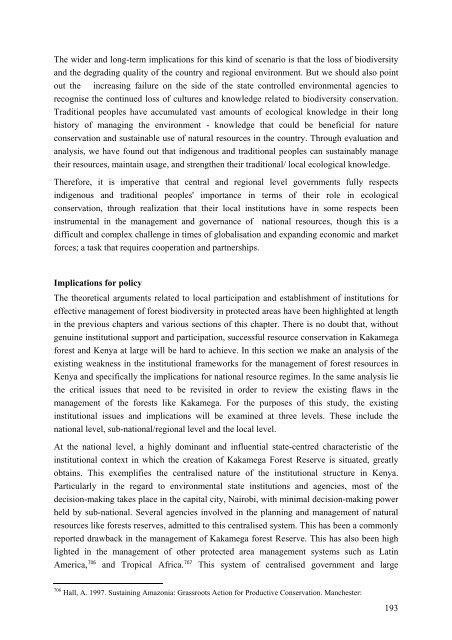THE UNIVERSITY OF LEIPZIG
THE UNIVERSITY OF LEIPZIG
THE UNIVERSITY OF LEIPZIG
Create successful ePaper yourself
Turn your PDF publications into a flip-book with our unique Google optimized e-Paper software.
The wider and long-term implications for this kind of scenario is that the loss of biodiversity<br />
and the degrading quality of the country and regional environment. But we should also point<br />
out the increasing failure on the side of the state controlled environmental agencies to<br />
recognise the continued loss of cultures and knowledge related to biodiversity conservation.<br />
Traditional peoples have accumulated vast amounts of ecological knowledge in their long<br />
history of managing the environment - knowledge that could be beneficial for nature<br />
conservation and sustainable use of natural resources in the country. Through evaluation and<br />
analysis, we have found out that indigenous and traditional peoples can sustainably manage<br />
their resources, maintain usage, and strengthen their traditional/ local ecological knowledge.<br />
Therefore, it is imperative that central and regional level governments fully respects<br />
indigenous and traditional peoples' importance in terms of their role in ecological<br />
conservation, through realization that their local institutions have in some respects been<br />
instrumental in the management and governance of national resources, though this is a<br />
difficult and complex challenge in times of globalisation and expanding economic and market<br />
forces; a task that requires cooperation and partnerships.<br />
Implications for policy<br />
The theoretical arguments related to local participation and establishment of institutions for<br />
effective management of forest biodiversity in protected areas have been highlighted at length<br />
in the previous chapters and various sections of this chapter. There is no doubt that, without<br />
genuine institutional support and participation, successful resource conservation in Kakamega<br />
forest and Kenya at large will be hard to achieve. In this section we make an analysis of the<br />
existing weakness in the institutional frameworks for the management of forest resources in<br />
Kenya and specifically the implications for national resource regimes. In the same analysis lie<br />
the critical issues that need to be revisited in order to review the existing flaws in the<br />
management of the forests like Kakamega. For the purposes of this study, the existing<br />
institutional issues and implications will be examined at three levels. These include the<br />
national level, sub-national/regional level and the local level.<br />
At the national level, a highly dominant and influential state-centred characteristic of the<br />
institutional context in which the creation of Kakamega Forest Reserve is situated, greatly<br />
obtains. This exemplifies the centralised nature of the institutional structure in Kenya.<br />
Particularly in the regard to environmental state institutions and agencies, most of the<br />
decision-making takes place in the capital city, Nairobi, with minimal decision-making power<br />
held by sub-national. Several agencies involved in the planning and management of natural<br />
resources like forests reserves, admitted to this centralised system. This has been a commonly<br />
reported drawback in the management of Kakamega forest Reserve. This has also been high<br />
lighted in the management of other protected area management systems such as Latin<br />
America, 706 and Tropical Africa. 707 This system of centralised government and large<br />
706 Hall, A. 1997. Sustaining Amazonia: Grassroots Action for Productive Conservation. Manchester:<br />
193






